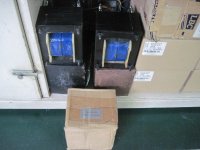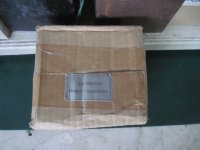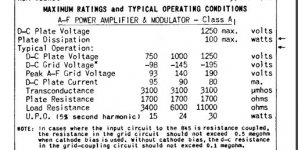HI,
This is for learning some basics for myself.
What would be the ideal specifications for an OPT for 845 tube working at plate voltage of 950V and 1200V.
How are the current and power rating of OPT are linked with Tubes DC plate current and power rating.
What type of core material and winding will give best value for money?
Thanks
This is for learning some basics for myself.
What would be the ideal specifications for an OPT for 845 tube working at plate voltage of 950V and 1200V.
How are the current and power rating of OPT are linked with Tubes DC plate current and power rating.
What type of core material and winding will give best value for money?
Thanks
An "ideal" (nebulous without more specifics) load for type 845 is about 10,000 Ohms reflected. This is at the raggedy edge of what can be done over the full audio range with DC in the core. Good commercial designs have 80 or so Henries, with DC, and weigh 11 or 12 pounds. I've used the now-ancient British-made Audio Note's happily, but would check out the Hammonds today.
All good fortune,
Chris
All good fortune,
Chris
Chris ,Thank you. What I am looking for though is not what is available. I am trying to learn how it is designed. For example , how did you calculate 10K is the impedence and not 16K?
For example , how did you calculate 10K is the impedence and not 16K?
Generally, you would begin by drawing some probable load lines on the plate curves to make sure you're in a linear area of the curves and operating at a safe dissipation. Then, you'd make a judgement call about speaker damping needed.
For all triodes, linearity and speaker damping increase with higher load impedance and (above an impractical lower level) distortion decreases. Type 845 is typically operated at about 1000 VDC and 80mA idle. A 10,000 Ohm reflected load means a speaker damping ratio of about 6 and a decent combination of maximum output (about +13dBW) and linearity.
But most importantly 10,000 Ohms is a reasonable compromise with the OPT's parasitic reactances, distributed shunt capacitance and leakage inductance, which are difficult issues for transformers with a lot of DC "in the core".
If this is all stuff you already know and you're really asking a different question, please forgive me and rephrase it somehow.
All good fortune,
Chris
Chris , really useful info and no I did not know these info. What do you think of 16K for primary Vs 10K at 1000V.
Chris , really useful info and no I did not know these info. What do you think of 16K for primary Vs 10K at 1000V.
Not Chris, sorry, but a 16K transformer is a real nightmare, to design and to winding, 1KV make things even more difficult but doable up to 10K. IMHO.
I have four cheap Chinese 211 (from better times) waiting for a proper 16K/8ohm transformer, so far all my attempts have failed, now I must wait to have the money for a couple of 300B (not my favourite) because of the transformer.
16K/8ohm transformer
if i were making these, i would probably design it to be an 8k to 4ohm traffo.
or even a 4k to 2 ohm traffo....
btw, i have a pair of ASL 1006 845 OPT's, dc resistance is at 450 ohms,
two vertical sections.....
if i were making these, i would probably design it to be an 8k to 4ohm traffo.
or even a 4k to 2 ohm traffo....
btw, i have a pair of ASL 1006 845 OPT's, dc resistance is at 450 ohms,
two vertical sections.....
Sure, it seems that you found the solution, good joke anyway. 😛😀
An "ideal" (nebulous without more specifics) load for type 845 is about 10,000 Ohms reflected. This is at the raggedy edge of what can be done over the full audio range with DC in the core. Good commercial designs have 80 or so Henries, with DC, and weigh 11 or 12 pounds. I've used the now-ancient British-made Audio Note's happily, but would check out the Hammonds today.
All good fortune,
Chris
i wonder how they arrived at 10k ohms,
i have seen designs where the reflected loads are three times rp,
or in case of the 2A3 with rp of 800 ohms, the load os 2.5k...
why is it that the 845 with an rp of 1700 ohms require 11k?
what did i miss?
Attachments
if i were making these, i would probably design it to be an 8k to 4ohm traffo.
or even a 4k to 2 ohm traffo....
btw, i have a pair of ASL 1006 845 OPT's, dc resistance is at 450 ohms,
two vertical sections.....
Winding ratio would be the same.
But what to do with primary inductance??
211 approaches 4k Rp.....
I have been working on a ~ 16k OPT for 211; this is territory where you meet the limits....
It is not strange that there are no commercial offerings for 211 OPT's with ~ 16k primary impedance.
To make a mistake here, with about 1KV is very dangerous and very expensive, then, for clarification let's suppose a lossless transformer.
Number of primary turns
Np = (Uac x 10⁸) / [√2 π fo S Bac(max)]
From the relation
W = (Uac)²/ Zp
It follows that
Uac = √(W Zp)
Using the first and the last equation, transformer turns ratio is
Np/Ns = Up/Us = √(Zp/Zs)
Let's suppose now three transformers with the same turns ratio
16KΩ/8Ω ... 8KΩ/4Ω ... 4KΩ/2Ω
Those transformers are equivalent, i.e. can be used in the same circuit, if
(Uac)²/Zp1 = (Uac)²/Zp2 = (Uac)²/Zp3
Then
(Uac)²/16KΩ = (Uac)²/8KΩ = (Uac)²/4KΩ
Which is physically impossible
Conclusion: The same turns ratio does not mean equivalent transformers.
Number of primary turns
Np = (Uac x 10⁸) / [√2 π fo S Bac(max)]
From the relation
W = (Uac)²/ Zp
It follows that
Uac = √(W Zp)
Using the first and the last equation, transformer turns ratio is
Np/Ns = Up/Us = √(Zp/Zs)
Let's suppose now three transformers with the same turns ratio
16KΩ/8Ω ... 8KΩ/4Ω ... 4KΩ/2Ω
Those transformers are equivalent, i.e. can be used in the same circuit, if
(Uac)²/Zp1 = (Uac)²/Zp2 = (Uac)²/Zp3
Then
(Uac)²/16KΩ = (Uac)²/8KΩ = (Uac)²/4KΩ
Which is physically impossible
Conclusion: The same turns ratio does not mean equivalent transformers.
Last edited:
A bit less enigmatic is to say that the 16k transformer needs more primary windings, but that is a well known fact.
A bit less enigmatic is to say that the 16k transformer needs more primary windings, but that is a well known fact.
Using the first and the third equation
Np = {[√(W Zp)] x 10⁸} / [√2 π fo S Bac(max)]
For the same power, the number of primary turns goes as the square root of primary impedance.
Last edited:
i wonder how they arrived at 10k ohms,
i have seen designs where the reflected loads are three times rp,
or in case of the 2A3 with rp of 800 ohms, the load os 2.5k...
why is it that the 845 with an rp of 1700 ohms require 11k?
what did i miss?
I didn't mean to sound dogmatic - all of these loading decisions are judgement calls. In the old days, and still for commercial designs, every last measurable watt must be extracted and Devil take the hindmost.
DIY designs can be optimized for other things, including linearity and speaker damping, and a dB or two peak output can be traded against that. In that context the optimum load for a type 2A3 would be 4000 or 5000 Ohms reflected, for example.
And these are just pretend numbers anyway; speakers are not resistive and also not 8 Ohms. The amplifier needs enough cushion to operate into a reactive load and a generally messy one at that!
All good fortune,
Chris
J&K Audio Design: 845 output transformer
Don't know how authentic the info is.
Note here that the (slightly) increased output into 16,000 Ohms is at the higher +1250 VDC plate voltage.
All good fortune,
Chris
i wonder how they arrived at 10k ohms,
i have seen designs where the reflected loads are three times rp,
or in case of the 2A3 with rp of 800 ohms, the load os 2.5k...
why is it that the 845 with an rp of 1700 ohms require 11k?
what did i miss?
It's written in the datasheet if you think more about it.
For the 2A3 you have the tube running at 250V/60mA to get 3.5-4W with the 845 you have the tube running at 1250V/80mA only to get 30W. Hence you need quite higher impedance otherwise the current won't be enough. You could use 5K (i.e. abour 3x plate resistance) but would not get 30W output power. Obviously if want to use 5K, 1250V plate voltage is not the best choice. 900V is about the right choice to get about 20W in class A1.
- Home
- Amplifiers
- Tubes / Valves
- OPT for 845 tube



